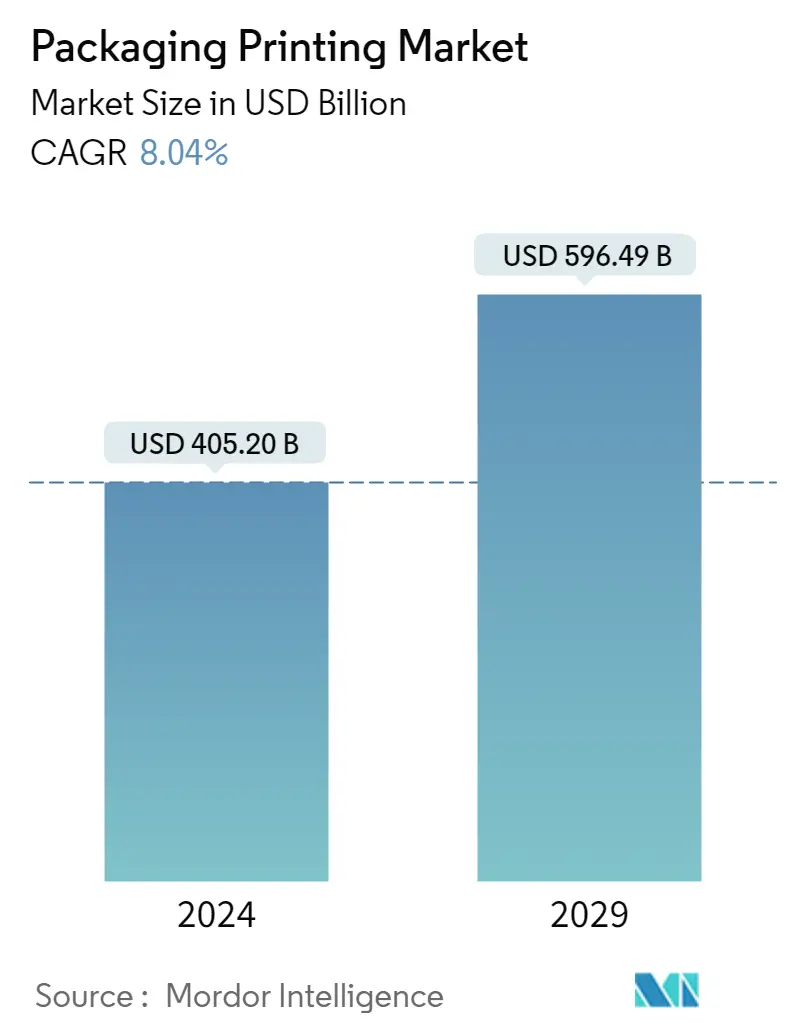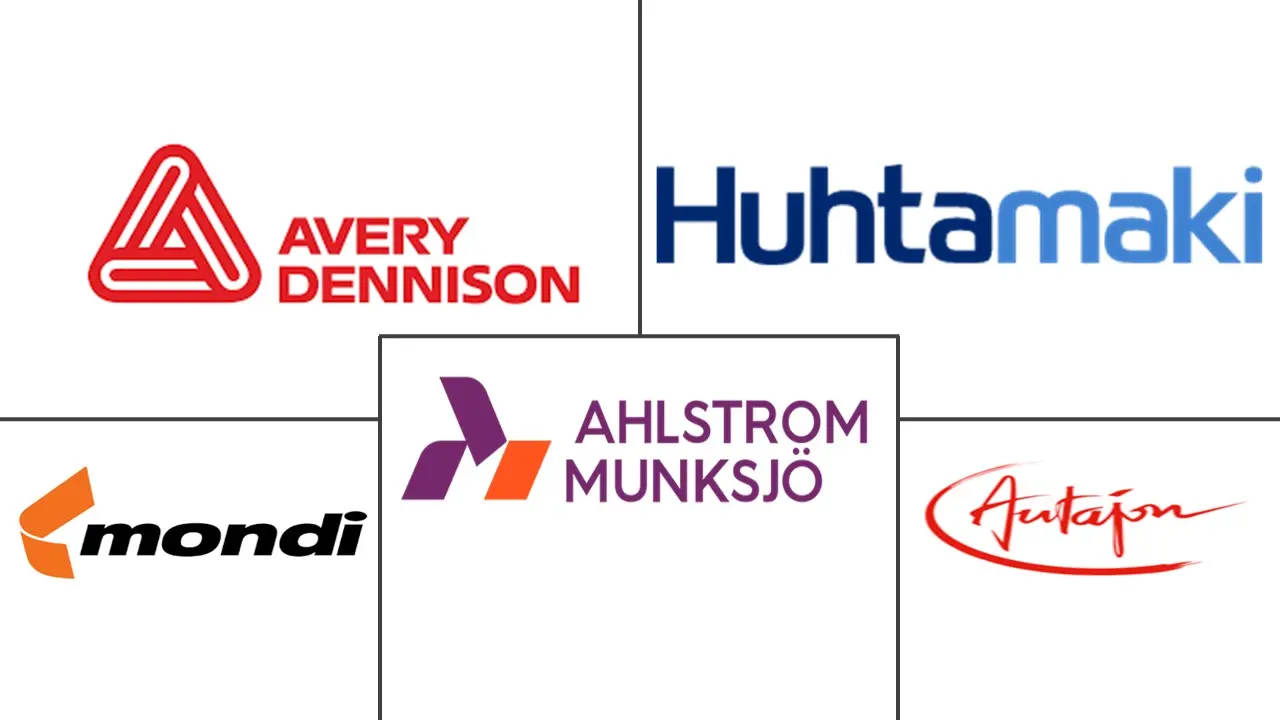Market Size of Packaging Printing Industry

| Study Period | 2019 - 2029 |
| Market Size (2024) | USD 405.20 Billion |
| Market Size (2029) | USD 596.49 Billion |
| CAGR (2024 - 2029) | 8.04 % |
| Fastest Growing Market | Asia Pacific |
| Largest Market | Asia-Pacific |
Major Players
*Disclaimer: Major Players sorted in no particular order |
Packaging Printing Market Analysis
The Packaging Printing Market size is estimated at USD 405.20 billion in 2024, and is expected to reach USD 596.49 billion by 2029, growing at a CAGR of 8.04% during the forecast period (2024-2029).
The technological advancements, coupled with demand for creative packaging, driven by intense competition and brand awareness, are expected to aid the growth of the market. The growing demand for innovative packaging from end-user segments, such as food, beverage, and cosmetics, among others, is expected to lead to the expansion of the market studied.
- The growth of the print label market is augmented by the rapid rise of digital print technology that has made the label printing market more sophisticated and increased the adoption of digital print labels. Their flexibility and versatility, along with the high graphics standards, are the major growth features. It is possible to print on metallic films, plastics, cellophane, paper, and corrugated surfaces using the flexographic method.
- Moreover, advancements such as AI, machine learning, IoT, and data analytics, have personalized offerings to a great extent. The convergence in digital printing enables superiority in terms of print personalization for large-volume orders. However, the cost factor remains a big hurdle.
- RFID (Radio Frequency Identification) uses radio waves to identify various "tagged" objects or people wirelessly. RFID technology plays a vital role in the market study because it enhances the effectiveness of printing technology. RFID-enabled printers come in various sizes and capacities and can be configured using RFID printer software to meet a wide range of security and other business needs.
- Development in the packaging printing industry, demand for aesthetics, product differentiation, and technological advancements are some digitally printed packaging market drivers. A significant initial investment is required to install production and printing equipment. Setting up a factory or purchasing a printing press requires higher investments. There is a growing demand for economical, sustainable, and innovative printing technologies.
- During COVID-19, as compared to other industries, fewer lockdowns were observed in the packaging industry as the packaging, food, beverage, and medical industries were considered essential. Furthermore, the huge demand for staples and medicines was due to panic-driven buying. Several supply chain constraints resulted in a mixed COVID-19 impact on the packaging printing market growth.
Packaging Printing Industry Segmentation
Packaging printing is defined as the process of printing packaging material, such as glass, metal, plastic, label, paper, and paperboard, among others, through various printing processes, such as offset lithography, rotogravure, flexography, digital printing, and screen printing, using different ink types. It is used across applications such as food and beverage and pharmaceutical.
The study tracks the key market parameters, underlying growth influencers, and major vendors operating in the industry, supporting the market estimations and growth rates over the forecast period. The study tracks the revenue accrued from the various types of packaging printing that are used across end-user industries. The study also provides the printing packaging market trends, along with key vendor profiles. It further analyses the overall impact of COVID-19 on the ecosystem.
| By Printing Technology | |
| Offset Lithography | |
| Rotogravure | |
| Flexography | |
| Digital Printing | |
| Screen Printing |
| By Ink Type | |
| Solvent-based Ink | |
| UV-curable Ink | |
| Aqueous Ink |
| By Packaging Type | |
| Label | |
| Plastic | |
| Glass | |
| Metal | |
| Paper and Paperboard |
| By Application | |
| Cosmetic and Homecare | |
| Food and Beverage | |
| Pharmaceutical | |
| Other Applications |
| By Geography | |
| North America | |
| Europe | |
| Asia Pacific | |
| Latin America | |
| Middle East and Africa |
Packaging Printing Market Size Summary
The packaging printing market is poised for significant growth, driven by technological advancements and the increasing demand for innovative and creative packaging solutions. This growth is particularly evident in sectors such as food, beverage, and cosmetics, where the need for product differentiation and brand awareness is paramount. The rise of digital print technology has further sophisticated the market, enhancing the flexibility and versatility of label printing. This has led to a broader adoption of digital print labels, which are capable of high graphics standards and can be applied to various surfaces using methods like flexography. Additionally, advancements in AI, machine learning, IoT, and data analytics have enabled more personalized printing offerings, although cost remains a significant barrier. The integration of RFID technology has also enhanced the effectiveness of packaging printing, offering improved security and business solutions.
The Asia-Pacific region is a key driver of growth in the packaging printing market, fueled by increasing consumer spending, a rise in processed food consumption, and a growing demand for sustainable products. The region's expanding food and beverage, pharmaceutical, and consumer electronics industries contribute to the rising demand for packaging solutions. The market is characterized by high competitive rivalry, with major players like Mondi PLC, Ahlstrom-Munksjö Oyj, and Avery Dennison Corporation leading through innovation and strategic partnerships. The COVID-19 pandemic has also impacted the market, with the packaging industry remaining resilient due to its essential role in food, beverage, and medical sectors. The demand for convenient and sustainable packaging solutions continues to rise, driven by changing consumer behaviors and the increasing popularity of e-commerce.
Packaging Printing Market Size - Table of Contents
-
1. MARKET INSIGHTS
-
1.1 Market Overview
-
1.2 Industry Value Chain Analysis
-
1.3 Industry Attractiveness - Porter's Five Forces Analysis
-
1.3.1 Bargaining Power of Suppliers
-
1.3.2 Bargaining Power of Buyers
-
1.3.3 Threat of New Entrants
-
1.3.4 Threat of Substitutes
-
1.3.5 Intensity of Competitive Rivalry
-
-
1.4 Market Drivers
-
1.4.1 Demand for the Use of RFIDs and Digital Printing
-
1.4.2 Growing Demand for Digital and Sustainable Packaging Printing
-
-
1.5 Market Restraints
-
1.5.1 High Capital Investments
-
1.5.2 Packaging and Printing Regulations
-
-
-
2. MARKET SEGMENTATION
-
2.1 By Printing Technology
-
2.1.1 Offset Lithography
-
2.1.2 Rotogravure
-
2.1.3 Flexography
-
2.1.4 Digital Printing
-
2.1.5 Screen Printing
-
-
2.2 By Ink Type
-
2.2.1 Solvent-based Ink
-
2.2.2 UV-curable Ink
-
2.2.3 Aqueous Ink
-
-
2.3 By Packaging Type
-
2.3.1 Label
-
2.3.2 Plastic
-
2.3.3 Glass
-
2.3.4 Metal
-
2.3.5 Paper and Paperboard
-
-
2.4 By Application
-
2.4.1 Cosmetic and Homecare
-
2.4.2 Food and Beverage
-
2.4.3 Pharmaceutical
-
2.4.4 Other Applications
-
-
2.5 By Geography
-
2.5.1 North America
-
2.5.2 Europe
-
2.5.3 Asia Pacific
-
2.5.4 Latin America
-
2.5.5 Middle East and Africa
-
-
Packaging Printing Market Size FAQs
How big is the Packaging Printing Market?
The Packaging Printing Market size is expected to reach USD 405.20 billion in 2024 and grow at a CAGR of 8.04% to reach USD 596.49 billion by 2029.
What is the current Packaging Printing Market size?
In 2024, the Packaging Printing Market size is expected to reach USD 405.20 billion.

